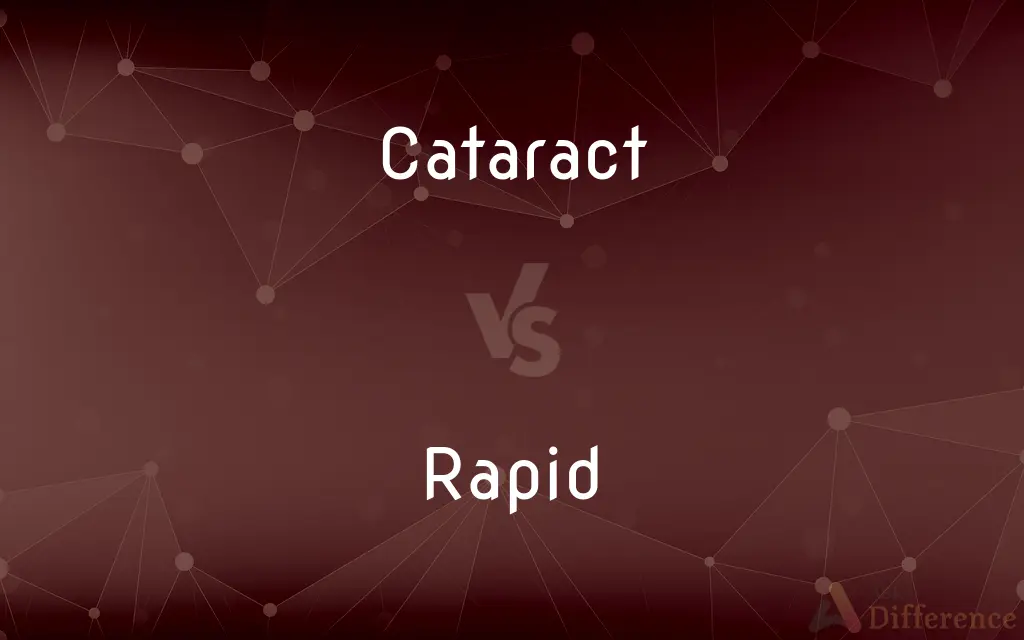Cataract vs. Rapid — What's the Difference?
Edited by Tayyaba Rehman — By Maham Liaqat — Updated on March 11, 2024
A cataract in geographical terms refers to a large, powerful waterfall, while a rapid is a fast-flowing and turbulent section of a river.

Difference Between Cataract and Rapid
Table of Contents
ADVERTISEMENT
Key Differences
Cataracts are characterized by their significant drop, where water descends steeply over a cliff or precipice, resulting in a spectacular waterfall. They are often landmarks or tourist attractions due to their grandeur and the scenic beauty of their surroundings. Rapids, on the other hand, occur in rivers where the water's flow is interrupted by sudden changes in elevation, rocks, or narrow passages, causing the water to become swift and choppy.
The formation of cataracts is typically associated with geological processes that create a significant vertical drop, such as tectonic movements, erosion, or the presence of hard rock layers resistant to erosion. Rapids form in areas where the riverbed has a steep gradient or where obstacles like boulders disrupt the water flow, creating turbulence.
In terms of scale and impact, cataracts are usually more expansive and can significantly alter the landscape, contributing to the development of ecosystems around them. Rapids are smaller in scale but can significantly affect river navigation and the surrounding ecosystem, providing unique habitats for various aquatic species.
Cataracts are often isolated features within a river system, serving as natural barriers to navigation and migration of aquatic species. Rapids can be numerous and spread out along a river, especially in mountainous or rugged terrains, presenting challenges and opportunities for river navigation and ecology.
While both cataracts and rapids add dynamic elements to river landscapes, their presence highlights the diverse and powerful forces of nature that shape the earth's surface. They offer opportunities for recreation, scientific study, and ecological conservation, each with its unique characteristics and challenges.
ADVERTISEMENT
Comparison Chart
Definition
A large, powerful waterfall.
A fast-flowing, turbulent section of a river.
Formation
Significant vertical drop due to geological processes.
Sudden changes in elevation, obstacles in the river.
Scale
Expansive, often altering the landscape.
Smaller scale, affecting river navigation and ecosystem.
Impact
Creates scenic landmarks, alters ecosystems.
Challenges navigation, provides habitat for aquatic species.
Occurrence
Isolated within river systems.
Numerous along rivers, especially in rugged terrains.
Compare with Definitions
Cataract
Characterized by a steep, large waterfall.
The Victoria Falls is one of the most famous cataracts in the world.
Rapid
Features fast, turbulent water flow.
The river's rapids are a popular spot for whitewater rafting.
Cataract
Can serve as natural barriers in a river.
The cataract creates a natural barrier that hinders fish migration.
Rapid
Caused by obstacles or steep gradients in the river.
Boulders in the riverbed create challenging rapids for kayakers.
Cataract
Formed by geological features creating a vertical drop.
The cataract's formation was influenced by the erosion-resistant rock layer.
Rapid
Attracts adventure sports enthusiasts.
The rapids offer thrilling experiences for experienced rafters.
Cataract
Often a focal point for tourism and recreation.
The cataract's surrounding area has developed into a major tourist attraction.
Rapid
Can be difficult to navigate, affecting river use.
The river's rapids make it impassable for large boats.
Cataract
Influences the development of adjacent ecosystems.
The mist from the cataract supports a unique microenvironment.
Rapid
Creates unique habitats for wildlife.
The rapids are home to species adapted to fast-flowing waters.
Cataract
A cataract is a cloudy area in the lens of the eye that leads to a decrease in vision. Cataracts often develop slowly and can affect one or both eyes.
Rapid
Moving, acting, or occurring with great speed. ]
Cataract
A large waterfall
The river descends in a succession of spectacular cataracts
Rapid
Very swift or quick.
A rapid stream
Rapid growth
Rapid improvement
Cataract
A medical condition in which the lens of the eye becomes progressively opaque, resulting in blurred vision
She had cataracts in both eyes
Rapid
Steep, changing altitude quickly. (of a slope)
Cataract
A large or high waterfall.
Rapid
Needing only a brief exposure time. (of a lens, plate, film, etc.)
Cataract
A great downpour; a deluge.
Rapid
Violent, severe.
Cataract
(Medicine) Opacity of the lens or capsule of the eye, causing impairment of vision or blindness.
Rapid
Happy.
Cataract
(obsolete) A waterspout.
Rapid
Rapidly.
Cataract
A large waterfall; steep rapids in a river.
The cataracts on the Nile helped to compartment Upper Egypt.
Rapid
A rough section of a river or stream which is difficult to navigate due to the swift and turbulent motion of the water.
Cataract
A flood of water.
Rapid
(dated) A burst of rapid fire.
Cataract
(figuratively) An overwhelming downpour or rush.
His cataract of eloquence
Rapid
(chess) rapid chess
Cataract
(pathology) A clouding of the lens in the eye leading to a decrease in vision.
Rapid
Very swift or quick; moving with celerity; fast; as, a rapid stream; a rapid flight; a rapid motion.
Ascend my chariot; guide the rapid wheels.
Cataract
A great fall of water over a precipice; a large waterfall.
Rapid
Advancing with haste or speed; speedy in progression; in quick sequence; as, rapid growth; rapid improvement; rapid recurrence; rapid succession.
Cataract
An opacity of the crystalline lens, or of its capsule, which prevents the passage of the rays of light and impairs or destroys the sight.
Rapid
Quick in execution; as, a rapid penman.
Cataract
A kind of hydraulic brake for regulating the action of pumping engines and other machines; - sometimes called dashpot.
Rapid
The part of a river where the current moves with great swiftness, but without actual waterfall or cascade; sometimes called whitewater; - usually used in the plural; as, the Lachine rapids in the St. Lawrence.
Row, brothers, row, the stream runs fast,The rapids are near, and the daylight's past.
Cataract
Clouding of the natural lens of the eye
Rapid
A part of a river where the current is very fast
Cataract
A large waterfall; violent rush of water over a precipice
Rapid
Done or occurring in a brief period of time;
A rapid rise through the ranks
Rapid
Characterized by speed; moving with or capable of moving with high speed;
A rapid movment
A speedy car
A speedy errand boy
Common Curiosities
What distinguishes a cataract from a rapid?
A cataract is a large waterfall with a significant vertical drop, while a rapid is characterized by fast, turbulent water flow due to elevation changes or obstacles.
How do cataracts affect their surroundings?
Cataracts can significantly alter their surroundings by creating misty environments that support unique ecosystems and by serving as natural barriers that impact aquatic migration and river navigation.
What factors contribute to the formation of rapids?
Rapids form due to factors like steep river gradients, the presence of rocks or boulders, and sudden constrictions in the river's path.
Are there any environmental concerns associated with cataracts and rapids?
Environmental concerns include the impact on local wildlife, especially aquatic species, and the potential effects of human recreation and tourism on these natural features.
Can human activities influence the formation or disappearance of cataracts or rapids?
Yes, human activities such as dam construction, river modification, and land use changes can impact the formation or preservation of cataracts and rapids.
How are cataracts and rapids studied scientifically?
Scientists study cataracts and rapids to understand geological processes, water dynamics, and the ecosystems they support, often using interdisciplinary approaches that include hydrology, geology, and biology.
Can cataracts and rapids coexist in the same river?
Yes, a river can feature both cataracts and rapids, depending on its topography and geological characteristics.
Are all waterfalls considered cataracts?
Not all waterfalls are cataracts; the term cataract is typically reserved for larger, more powerful waterfalls.
Why are rapids popular for water sports?
Rapids are favored for water sports due to their challenging, dynamic water flow, which provides thrilling and engaging experiences for enthusiasts.
What role do cataracts and rapids play in cultural or historical contexts?
Cataracts and rapids have played roles in human history and culture as landmarks, natural barriers, and sources of myth and legend, influencing settlement patterns and transportation routes.
Share Your Discovery

Previous Comparison
Octant vs. Quadrant
Next Comparison
Agnostic vs. SkepticAuthor Spotlight
Written by
Maham LiaqatEdited by
Tayyaba RehmanTayyaba Rehman is a distinguished writer, currently serving as a primary contributor to askdifference.com. As a researcher in semantics and etymology, Tayyaba's passion for the complexity of languages and their distinctions has found a perfect home on the platform. Tayyaba delves into the intricacies of language, distinguishing between commonly confused words and phrases, thereby providing clarity for readers worldwide.














































